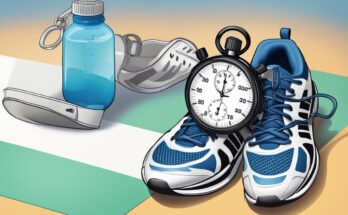Running can be a powerful tool for individuals with mental health conditions such as bipolar disorder and obsessive-compulsive disorder (OCD). While these conditions can make it challenging to maintain a consistent exercise routine, running can provide a sense of control and structure that can be beneficial for managing symptoms.
For individuals with bipolar disorder, running can help regulate mood swings and promote a more stable emotional state. Studies have shown that exercise can increase levels of endorphins and other neurotransmitters that play a role in mood regulation. Additionally, running can provide a healthy outlet for managing stress and anxiety, which are common triggers for bipolar symptoms.
Similarly, for individuals with OCD, running can offer a sense of control and structure that can be helpful for managing obsessive thoughts and compulsive behaviors. Running can provide a sense of accomplishment and a distraction from intrusive thoughts, while also promoting a more positive self-image. However, it is important to note that running should not be used as a substitute for professional treatment for these conditions.
Understanding Bipolar and OCD
Bipolar disorder and OCD are both mental health conditions that can significantly impact an individual’s life. While they are distinct conditions, they can sometimes occur together, known as comorbidity.
Bipolar Disorder
Bipolar disorder is a mood disorder that causes extreme mood swings. These mood swings can range from highs (mania or hypomania) to lows (depression). Individuals with bipolar disorder may experience periods of elevated mood, increased energy, and decreased need for sleep during manic episodes. During depressive episodes, they may feel sad, hopeless, and lack interest in activities they once enjoyed.
Bipolar disorder is a chronic condition that requires ongoing management. Treatment typically involves a combination of medication and therapy.
OCD
OCD is a type of anxiety disorder characterized by intrusive thoughts (obsessions) and repetitive behaviors (compulsions). Individuals with OCD may feel compelled to perform certain actions or rituals to alleviate anxiety caused by their intrusive thoughts.
OCD can significantly impact an individual’s daily life, making it difficult to complete tasks or engage in social situations. Treatment for OCD typically involves therapy, medication, or a combination of both.
Comorbidity
Comorbidity refers to the presence of multiple conditions in an individual. Bipolar disorder and OCD can occur together, and individuals with both conditions may experience more severe symptoms than those with only one.
It is essential to receive proper treatment for both conditions when comorbidity is present. Treatment may involve a combination of medication and therapy tailored to the individual’s specific needs.
Overall, understanding bipolar disorder and OCD is crucial in managing these conditions. With proper treatment and support, individuals with these conditions can lead fulfilling lives.
Symptoms and Diagnosis
Individuals with bipolar disorder and OCD may experience a range of symptoms that can be disruptive to their daily lives. Symptoms of bipolar disorder can include periods of mania, where the individual experiences an elevated mood, increased energy, and decreased need for sleep, as well as major depressive episodes, where the individual experiences sadness, loss of interest in activities, and changes in appetite and sleep patterns.
Symptoms of OCD can include obsessions, which are recurrent intrusive thoughts or images that can be difficult to control, as well as compulsions, which are repetitive behaviors or mental acts that the individual feels compelled to perform in response to their obsessions. These symptoms can be time-consuming and interfere with daily activities.
Diagnosis of bipolar disorder and OCD typically involves a clinical interview with a mental health professional, who will assess the individual’s clinical features and determine whether they meet the criteria for these disorders. The diagnostic criteria for bipolar disorder and OCD are outlined in the Diagnostic and Statistical Manual of Mental Disorders (DSM-5).
In addition to bipolar disorder and OCD, individuals with these conditions may also be diagnosed with an anxiety disorder, such as panic disorder or generalized anxiety disorder. These disorders can involve fear, worry, and physical symptoms such as heart palpitations or sweating.
Overall, the symptoms and diagnosis of bipolar disorder and OCD can be complex and require a thorough evaluation by a mental health professional. It is important for individuals to seek treatment if they are experiencing symptoms that are disruptive to their daily lives.
Prevalence and Age Factors
Bipolar disorder and OCD are prevalent mental health conditions that can significantly impact an individual’s life. According to the National Institute of Mental Health (NIMH), approximately 2.8% of adults in the United States have bipolar disorder, while OCD affects around 1.2% of adults.
The prevalence of these conditions varies by age, with bipolar disorder typically emerging in late adolescence or early adulthood. The average age of onset for bipolar disorder is 25 years, although it can occur at any age. In contrast, OCD often begins in childhood, with the average age of onset being 19 years. However, it can also develop later in life.
Lifetime prevalence rates for bipolar disorder and OCD are also significant. The NIMH reports that the lifetime prevalence rate for bipolar disorder is approximately 4.4%, while the lifetime prevalence rate for OCD is around 2.3%.
It is important to note that these prevalence rates may be underestimates, as many individuals with bipolar disorder or OCD may not seek treatment or receive a proper diagnosis. Additionally, these conditions are often comorbid with other mental health disorders, such as anxiety or substance abuse, which can complicate diagnosis and treatment.
Overall, understanding the prevalence and age factors of bipolar disorder and OCD can help individuals and healthcare providers recognize and address these conditions in a timely and effective manner.
Treatment Strategies
Treatment strategies for running with bipolar and OCD typically involve a combination of medication and psychotherapy. Mood stabilizers such as lithium, valproate, and carbamazepine may be prescribed to help manage bipolar symptoms, while selective serotonin reuptake inhibitors (SSRIs) and cognitive behavioral therapy (CBT) may be used to treat OCD.
Exposure and response prevention (ERP) is a type of CBT that has been shown to be effective in treating OCD. It involves gradually exposing the person to their fears and obsessions while preventing them from engaging in compulsive behaviors. This helps to break the cycle of obsessions and compulsions and reduce anxiety.
Transcranial magnetic stimulation (TMS) and electroconvulsive therapy (ECT) may also be used in some cases. TMS involves using magnetic fields to stimulate nerve cells in the brain, while ECT involves passing electrical currents through the brain to produce a seizure. Both treatments have been shown to be effective in treating severe depression and other mental health conditions.
Anticonvulsants such as lamotrigine and topiramate may also be used to treat bipolar disorder and OCD. These medications help to stabilize mood and reduce anxiety.
A comprehensive treatment plan for running with bipolar and OCD may include pharmacotherapy, psychotherapy, and rehabilitation. Supplements such as omega-3 fatty acids and N-acetylcysteine (NAC) may also be helpful in managing symptoms.
Overall, treatment strategies for running with bipolar and OCD should be individualized to meet the specific needs of the person. A combination of medication and psychotherapy is often the most effective approach, and regular monitoring and adjustment of the treatment plan may be necessary to achieve the best outcomes.
Role of Medication
Medication is often a crucial component in the treatment of bipolar disorder and OCD. The right medication can help stabilize mood, reduce anxiety, and alleviate symptoms of both disorders. However, finding the right medication and dosage can be a complex process that requires careful monitoring and adjustment.
Mood stabilizers are often used to treat bipolar disorder. These medications help regulate mood swings and prevent episodes of mania or depression. Common mood stabilizers include lithium, valproic acid, and carbamazepine. Antipsychotic medications may also be used in combination with mood stabilizers to manage symptoms of mania or psychosis.
Selective serotonin reuptake inhibitors (SSRIs) and serotonin-norepinephrine reuptake inhibitors (SNRIs) are commonly prescribed to treat OCD. These medications work by increasing levels of serotonin in the brain, which can help reduce anxiety and compulsive behaviors. Clomipramine, a tricyclic antidepressant, is also effective in treating OCD.
Atypical antipsychotics may also be used to treat OCD, particularly in cases where other medications have not been effective. These medications can help reduce anxiety and obsessive thoughts.
It is important to note that medication can have side effects and may interact with other medications. It is crucial for individuals to work closely with their healthcare provider to find the right medication and dosage. Regular monitoring and adjustments may be necessary to ensure the medication is effective and well-tolerated.
In summary, medication plays an important role in the treatment of bipolar disorder and OCD. Mood stabilizers, antipsychotics, SSRIs, and atypical antipsychotics may be used to manage symptoms. However, finding the right medication and dosage can be a complex process that requires careful monitoring and adjustment. Individuals should work closely with their healthcare provider to ensure the medication is effective and well-tolerated.
Coping Mechanisms and Behavioral Patterns
Individuals with bipolar disorder and OCD may experience a variety of distressing symptoms, including racing thoughts, patterns of behavior, and disrupted sleep patterns. Coping mechanisms and behavioral patterns can help individuals manage these symptoms and maintain a sense of control.
One common coping mechanism is the use of mindfulness techniques. This involves focusing on the present moment and accepting thoughts and emotions without judgment. Mindfulness can help individuals with bipolar disorder and OCD reduce their distress and improve their ability to cope with challenging situations.
Another important coping mechanism is the development of healthy sleep patterns. Regular sleep is essential for maintaining mental health, and disruptions in sleep can trigger symptoms of bipolar disorder and OCD. Individuals may benefit from establishing a regular sleep routine, avoiding caffeine and alcohol before bedtime, and creating a calming sleep environment.
Individuals with bipolar disorder and OCD may also benefit from developing coping strategies for specific symptoms, such as racing thoughts or checking and cleaning rituals. Cognitive-behavioral therapy (CBT) can help individuals identify and challenge negative thought patterns and develop more adaptive coping strategies.
Finally, it is important to recognize that there are different subtypes of bipolar disorder and OCD, and that different coping mechanisms may be more effective for different individuals. For example, individuals with bipolar disorder may benefit from medication management in addition to psychotherapy, while individuals with OCD may benefit from exposure and response prevention (ERP) therapy to help reduce compulsive behaviors.
Overall, coping mechanisms and behavioral patterns can be effective tools for managing symptoms of bipolar disorder and OCD. By developing healthy coping strategies and seeking appropriate treatment, individuals can improve their quality of life and maintain a sense of control over their mental health.
Professional Help and Therapies
Individuals with bipolar disorder and OCD often require professional help and therapies to manage their symptoms effectively. Treatment outcomes can vary, and it may take some time to find the right treatment approach that works best for each individual.
Hospitalization may be necessary in severe cases, particularly if the individual is experiencing suicidal thoughts or behaviors. Hospitalization can provide a safe and supportive environment to stabilize the individual’s mood and behavior.
It is not uncommon for bipolar disorder and OCD to co-occur, making it important to find a healthcare professional who is knowledgeable about both conditions. A therapist can provide psychoeducation about the conditions, help the individual develop coping skills, and provide support and guidance.
Interpersonal and social rhythm therapy (IPSRT) is a specialized form of psychotherapy that has been found to be effective in treating bipolar disorder. IPSRT focuses on stabilizing the individual’s daily routines and improving interpersonal relationships.
The DSM-5 is the standard classification system used in the United States to diagnose mental health disorders. A healthcare professional can use the DSM-5 to diagnose bipolar disorder and OCD and develop an appropriate treatment plan.
Overall, seeking professional help and therapies can significantly improve an individual’s quality of life and ability to manage their symptoms. It is important to work closely with a healthcare professional to find the right treatment approach that works best for each individual.
Research and Future Directions
Research on the relationship between running and mental health has been growing in recent years. However, there is still a lack of research on the specific topic of running with bipolar and OCD. The few studies that have been conducted suggest that running can be beneficial for individuals with these conditions.
One study found that running can reduce symptoms of bipolar disorder, including depression and mania. Another study found that running can decrease symptoms of OCD, such as compulsions and intrusive thoughts. However, more research is needed to fully understand the relationship between running and these conditions.
In terms of future directions, it would be beneficial to conduct more studies on the effects of running on bipolar disorder and OCD. These studies should use a structured clinical interview to accurately diagnose participants and measure outcomes. It would also be helpful to investigate the potential triggers for symptoms during running, as well as the effects of running on comorbid conditions such as psychosis and schizophrenia.
Overall, while the research on running with bipolar and OCD is limited, the existing studies suggest that running can be a helpful tool in managing symptoms. Further research is needed to fully understand the relationship between running and these conditions and to develop structured interventions that can lead to remission.
Conclusion
In conclusion, running can be a beneficial and effective way to manage symptoms of bipolar disorder and OCD. While it is not a cure, it can certainly help individuals cope with their conditions and improve their overall well-being.
Through running, individuals can experience a sense of accomplishment and control, which can be empowering for those struggling with mental health issues. Additionally, the physical benefits of running, such as improved cardiovascular health and increased endorphins, can also positively impact mental health.
It is important to note that running should not be used as a replacement for professional treatment or medication. However, it can be a valuable addition to a comprehensive treatment plan.
Overall, running with bipolar disorder and OCD can be challenging, but it is possible with the right mindset, support, and resources. By incorporating running into their daily routine, individuals can take an active role in managing their mental health and improving their quality of life.




